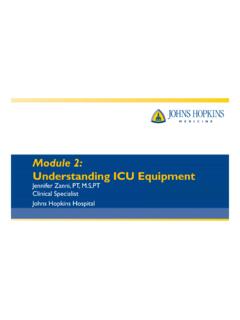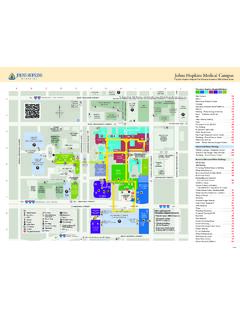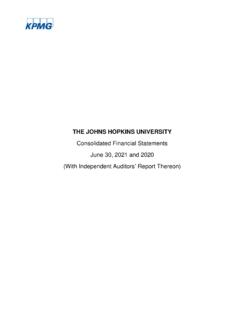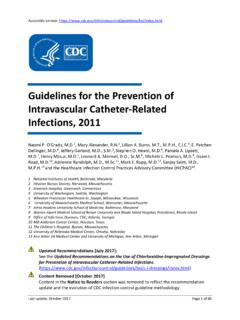Transcription of Module 4: Understanding MechanicalVentilation
1 Module 4: Understanding Mechanical VentilationJennifer Zanni, PT, DScPT Johns hopkins HospitalObjectivesUpon completion of this Module , the learner will be able to: Identify types of airways and indications and precautions of each Identify common modes of ventilation and be able to describe the assistance each mode provides Interpret common alarms associated with mechanical ventilation and indicate an action for each Describe possible complicationsassociated with mechanical ventilation Discuss and synthesize common weaning parameters and methodsWhy is mechanical ventilationrequired? Impending or existing respiratory failure Failure to oxygenate (inadequate exchange of gases at the alveolarlevel, as seen in acute respiratory distress syndrome [ARDS]) Failure to ventilate (decreased mental status or decreased lungcompliance) Combination of both Airway protectionCheung AM et al.
2 Am J Respir Crit Care 1 2006;174(5):538-544. Fletcher SN et Care 2003;31(4) MS et al. N Engl J 20 2003;348(8) things to What type of airway is in place? What are the ventilator settings and what do they all mean? What do I do if the vent alarms? What to I do if the vent fails? How do I plan treatment in conjunction with vent weaning?Start with the ABC Management Endotracheal Tube (ETT) Can be placed orally (most common) or nasally Passes through the vocal cordsAirway Management Tracheostomy tube Cuff or cuff less Inserted below the vocal cords Used in more long-term airwaymanagementAirway Management Airway cuffs: Assist with holding the airway in place Allow positive pressure ventilation without loss of tidal volume May reduce risk of aspiration of oral and gastric secretions If patient can talk or is losing tidal volume, the cuff may not be fully inflatedVentilator Settings Tidal Volume PEEP Mode (type of assist given by vent) Rate (Breaths per based on patient s own respiratory rate) FiO2 (amount of O2 being delivered)
3 Type of respirationModeSet respiratory rateActual respiratory rateFiO2 PEEPPEEP Positive End-Expiratory Pressure Pressure given in expiratory phase to prevent closure of the alveoli and allow increased time for O2 exchange Used in pts who haven t responded to treatment and are requiring high amount of FiO2 PEEP will lower O2 requirements by recruiting more surface area Normal PEEP is approximately 5cmH20. Can be as high as 20cmH20 Oxygen Therapy Prolonged exposure to high levels of oxygen can be toxic to the lungs High FiO2 (>.5) can lead to atelactasis Balancing act between FiO2 and PEEPM odes of VentilationModes of Ventilation Controlled Ventilation Vent initiates all breaths at a pre-set rate and tidal volume Vent will block any spontaneous breaths Used mainly in the OR for paralyzed and of Ventilation Assist Control (A/C) Vent will allow a patient to initiate a breath and then vent will deliver a pre-set tidal volume Machine set at a minimum rate so apnea will not occur if the patient does not initiate a breath Disadvantages.
4 Hyperventilation if patient has increased respiratory rate (can lead to respiratory alkalosis) Vent dysynchrony, breath-stackingAssist Control (A/C) Breath-Stacking Modes of Ventilation Synchronized Intermittent Ventilation (SIMV) Similar to A/C, but patients can take own breaths with their own TV between mechanically assisted breaths Can be used as a primary mode or a weaning mode May lead to a low respiratory rate in a patient who does not initiate breaths if set rate is lowSIMVM odes of Ventilation Pressure Support Ventilation (PSV) Also called spontaneous mode Pt initiates breath & vent delivers a pre-set inspiratory pressure to help overcome airway resistance and keeps airways open Patient controls the rate, tidal volume, and minute ventilation Tidal volume is variable Can be used in conjunction with SIMV or CPAP settingsPressure Support (PS)Modes of Ventilation Continuous Positive Airway Pressure (CPAP)
5 Positive airway pressure provided during both inspiration andexpiration Vent provides O2 and alarms, but no respirations Improves gas exchange and oxygenation in patients able tobreathe on their own Can also be used non-invasively via a face or nasal mask for patients with sleep apneaModes of Ventilation Airway Pressure Release Ventilation (APRV) Differs from conventional vent Elevation of airway pressures with brief intermittent releases of airway pressure Facilitates oxygenation and CO2 clearance May be an improved way to treat ALI/ ARDSNon-Invasive Ventilation (NIV) Bi-Level Airway pressure (BiPAP) Delivered by mask, not through an airway Similar to CPAP, but can be set at one pressure for inhalation and another for exhalation.
6 Used in sleep apnea, but also has been found to be useful in patients with CHF and respiratory failure to avoid intubationVe n t A l a r m sHigh Pressure Alarm(common alarm to come and serious if it continues to alarm): Secretions/ needs to be suctioned (common) Kinked tubing/ malposition of ETT Pt biting tube/ fighting vent Water in tubing(common) Bronchospasm Pneumothorax Decreased compliance( )Ve n t A l a r m s Low Pressure Alarm Tubing disconnect from vent Leak in cuff or tubing connections (if patient can talk aroundtrach, a leak in the cuff is probable) Extubation Also alarms for tidal volume, rate, temperature, and O2Ve n t A l a r m s General Look at the patient first!
7 !! Then follow tubing to the vent tosearch for any disconnections. If can t find the problem and the patient is in distress, disconnect the patient from the vent and bag with 100% O2 (and call for help)Complications of Mech Vent Asynchrony ( bucking ) AutoPEEP Patient doesn t expire full tidal volume and air becomes trapped Can cause increased alveolar damage Barotrauma Damage to alveoli caused by increased pressure and volumeComplications of Mech Vent Hemodynamic compromise Nosocomial infection Anxiety/ Stress/ Sleep deprivation Ulcers/ Gastritis/ Malnutrition Muscle deconditioning/ Vent dependence Increased intrathoracic pressure leading to systemicedema due to decreased venous returnWeaning parameters Adequate Oxygenation PaO2 >60-70 on FiO2.
8 4 to .5, PEEP 5-8cmH20 PaO2/FiO2 ratio >150-200 Adequate Ventilation PaCO2 35-45mmHg pH to parameters Adequate Respiratory Mechanics Tidal Volume Respiratory Capacity Minute Ventilation Hemodynamic StabilitySpontaneous Breathing Trials(SBT) Spontaneous breathing trials (whether single or multiple trials) lead to extubation more quicklythan those receiving Pressure Support and IMV forweaning purposes in patients who are mechanicallyventilated for > 1 weekWeaning parameters Signs of distress during Increased tachypnea (>30) Increased heart rate Irregular breathing pattern or use of accessory muscles Agitation or panic unrelieved by assurance Decrease pH to less than with increasing PCO2 Treatment Guidelines ConsidertheneedforincreasedFiO2orventsup portprior to mobilizing a patient in order to maximize theirpulmonary status Communicate with medical team to discuss best settings Consider how weaning trials may affect the patient s ability to participate in therapy.
9 May want to coordinate working with patients around weaning schedules, and not duringMobilizing the Patient requiringMechanical Ventilation Patients weaning from mechanical ventilation Consider each patient s case and determine their ability totolerate both spontaneous breathing trials (SBTs) and rehab sessions May be optimal to treat prior to SBT or after they are rested Consider mobility and strengthening first, then weaningAmbulating a Patient on MechVe n t Requires teamwork with the entire medical team Most standard ventilators do not run on likely need to use a portable ventilator or an ambu-bag to ventilate the patient while mobilizingAmbulating a Patient on MechVe n t ETT placement Make sure tape is secure prior to moving patient!
10 !! Look at cm mark at lip before and after treatment to assure no movement had occurred May want to talk with team if patient has an FiO2of .60 or greater and/or if PEEP is -10cm H2O orgreater to ensure medical stabilitySteps to Look at Baseline to Look at Baseline Vent to Locate all, wires, tubes, to Move IV pole and linesto the side you are getting up on (usuallytowards the vent)Steps to Assist patient to sittingat the side of the bedtowards the vent, making sure that all lines are accounted forand have enough slackSteps to Transfer to the chairwhile managing lines toensure clearanceSteps to Try to consolidate equipment together asbest as you canSteps to Coordinate with RTto place on portablevent (if necessary)








